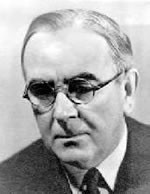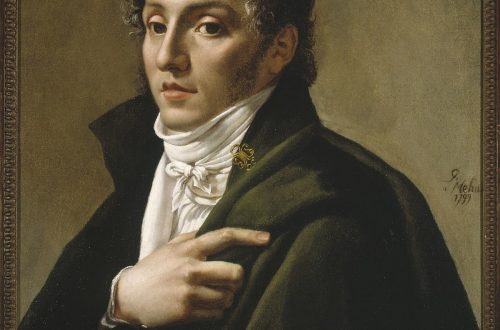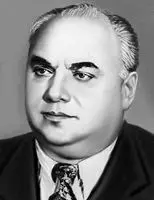
Alexander Sergeevich Dargomyzhsky |
Alexander Dargomyzhsky
Dargomyzhsky. “Old Corporal” (Spanish: Fedor Chaliapin)
I don’t intend to reduce…music to fun. I want the sound to directly express the word. I want the truth. A. Dargomyzhsky

At the beginning of 1835, a young man appeared in the house of M. Glinka, who turned out to be a passionate lover of music. Short, outwardly unremarkable, he completely transformed at the piano, delighting those around him with free play and excellent reading of notes from a sheet. It was A. Dargomyzhsky, in the near future the largest representative of Russian classical music. The biographies of both composers have much in common. Dargomyzhsky’s early childhood was spent on his father’s estate not far from Novospassky, and he was surrounded by the same nature and peasant way of life as Glinka. But he came to St. Petersburg at an earlier age (the family moved to the capital when he was 4 years old), and this left its mark on artistic tastes and determined his interest in the music of urban life.
Dargomyzhsky received a homely, but broad and versatile education, in which poetry, theater, and music occupied the first place. At the age of 7, he was taught to play the piano, violin (later he took singing lessons). A craving for musical writing was discovered early, but it was not encouraged by his teacher A. Danilevsky. Dargomyzhsky completed his pianistic education with F. Schoberlechner, a student of the famous I. Hummel, studying with him in 1828-31. During these years, he often performed as a pianist, participated in quartet evenings and showed an increasing interest in composition. Nevertheless, in this area Dargomyzhsky still remained an amateur. There was not enough theoretical knowledge, besides, the young man plunged headlong into the whirlpool of secular life, “was in the heat of youth and in the claws of pleasures.” True, even then there was not only entertainment. Dargomyzhsky attends musical and literary evenings in the salons of V. Odoevsky, S. Karamzina, happens in the circle of poets, artists, artists, musicians. However, his acquaintance with Glinka made a complete revolution in his life. “The same education, the same love for art immediately brought us closer … We soon got together and sincerely became friends. … For 22 years in a row we were constantly in the shortest, most friendly relations with him, ”Dargomyzhsky wrote in an autobiographical note.
It was then that Dargomyzhsky for the first time really faced the question of the meaning of composer’s creativity. He was present at the birth of the first classical Russian opera “Ivan Susanin”, took part in its stage rehearsals and saw with his own eyes that music is intended not only to delight and entertain. Music-making in the salons was abandoned, and Dargomyzhsky began to fill in the gaps in his musical and theoretical knowledge. For this purpose, Glinka gave Dargomyzhsky 5 notebooks containing lecture notes by the German theorist Z. Dehn.
In his first creative experiments, Dargomyzhsky already showed great artistic independence. He was attracted by the images of “humiliated and offended”, he seeks to recreate in music a variety of human characters, warming them with his sympathy and compassion. All this influenced the choice of the first opera plot. In 1839 Dargomyzhsky completed the opera Esmeralda to a French libretto by V. Hugo based on his novel Notre Dame Cathedral. Its premiere took place only in 1848, and “these eight years vain waiting,” wrote Dargomyzhsky, “lay a heavy burden on all my artistic activity.”
The failure also accompanied the next major work – the cantata “The Triumph of Bacchus” (on the st. A. Pushkin, 1843), reworked in 1848 into an opera-ballet and staged only in 1867. “Esmeralda”, which was the first attempt to embody the psychological drama ” little people”, and “The Triumph of Bacchus”, where it took place for the first time as part of a large-scale work of wind with ingenious Pushkin’s poetry, with all the imperfections, were a serious step towards the “Mermaid”. Numerous romances also paved the way to it. It was in this genre that Dargomyzhsky somehow easily and naturally reached the top. He loved vocal music-making, until the end of his life he was engaged in pedagogy. “… Constantly addressing in the company of singers and singers, I practically managed to study both the properties and bends of human voices, and the art of dramatic singing,” Dargomyzhsky wrote. In his youth, the composer often paid tribute to salon lyrics, but even in his early romances he comes into contact with the main themes of his work. So the lively vaudeville song “I confess, uncle” (Art. A. Timofeev) anticipates the satirical songs-sketches of a later time; the topical theme of the freedom of human feeling is embodied in the ballad “Wedding” (Art. A. Timofeev), so loved later by V. I. Lenin. In the early 40s. Dargomyzhsky turned to Pushkin’s poetry, creating such masterpieces as the romances “I loved you”, “Young man and maiden”, “Night marshmallow”, “Vertograd”. Pushkin’s poetry helped to overcome the influence of the sensitive salon style, stimulated the search for more subtle musical expressiveness. The relationship between words and music became ever closer, requiring the renewal of all means, and first of all, melody. The musical intonation, fixing the curves of human speech, helped to fashion a real, living image, and this led to the formation of new varieties of romance in Dargomyzhsky’s chamber vocal work – lyrical-psychological monologues (“I’m sad”, “Both bored and sad” on st. M . Lermontov), theatrical genre-everyday romances-sketches (“Melnik” at Pushkin Station).
An important role in the creative biography of Dargomyzhsky was played by a trip abroad at the end of 1844 (Berlin, Brussels, Vienna, Paris). Its main result is an irresistible need to “write in Russian”, and over the years this desire has become more and more clearly socially oriented, echoing the ideas and artistic searches of the era. The revolutionary situation in Europe, the tightening of the political reaction in Russia, the growing peasant unrest, anti-serfdom tendencies among the advanced part of Russian society, the growing interest in folk life in all its manifestations – all this contributed to serious shifts in Russian culture, primarily in literature, where by the mid 40s. the so-called “natural school” was formed. Its main feature, according to V. Belinsky, was “in closer and closer rapprochement with life, with reality, in greater and greater proximity to maturity and manhood.” The themes and plots of the “natural school” – the life of a simple class in its unvarnished everyday life, the psychology of a small person – were very in tune with Dargomyzhsky, and this was especially evident in the opera “Mermaid”, accusatory romances of the late 50s. (“Worm”, “Titular Advisor”, “Old Corporal”).
Mermaid, on which Dargomyzhsky worked intermittently from 1845 to 1855, opened a new direction in Russian opera art. This is a lyric-psychological everyday drama, its most remarkable pages are extended ensemble scenes, where complex human characters enter into acute conflict relationships and are revealed with great tragic force. The first performance of The Mermaid on May 4, 1856 in St. Petersburg aroused public interest, but the high society did not honor the opera with their attention, and the directorate of the imperial theaters treated it unkindly. The situation changed in the mid-60s. Resumed under the direction of E. Napravnik, “Mermaid” was a truly triumphant success, noted by critics as a sign that “the views of the public … have changed radically.” These changes were caused by the renewal of the entire social atmosphere, the democratization of all forms of public life. Attitude towards Dargomyzhsky became different. Over the past decade, his authority in the music world has greatly increased, around him united a group of young composers headed by M. Balakirev and V. Stasov. The composer’s musical and social activities also intensified. At the end of the 50s. he took part in the work of the satirical magazine “Iskra”, since 1859 he became a member of the committee of the RMO, participated in the development of the draft charter of the St. Petersburg Conservatory. So when in 1864 Dargomyzhsky undertook a new trip abroad, the foreign public in his person welcomed a major representative of Russian musical culture.
In the 60s. expanded the range of creative interests of the composer. The symphonic plays Baba Yaga (1862), Cossack Boy (1864), Chukhonskaya Fantasy (1867) appeared, and the idea of reforming the operatic genre grew ever stronger. Its implementation was the opera The Stone Guest, on which Dargomyzhsky has been working for the past few years, the most radical and consistent embodiment of the artistic principle formulated by the composer: “I want the sound to directly express the word.” Dargomyzhsky renounces here the historically established opera forms, writes music to the original text of Pushkin’s tragedy. Vocal-speech intonation plays a leading role in this opera, being the main means of characterizing the characters and the basis of musical development. Dargomyzhsky did not have time to finish his last opera, and, according to his desire, it was completed by C. Cui and N. Rimsky-Korsakov. “Kuchkists” highly appreciated this work. Stasov wrote about him as “an extraordinary work that goes beyond all the rules and from all examples,” and in Dargomyzhsky he saw a composer of “extraordinary novelty and power, who created in his music … human characters with truthfulness and depth of truly Shakespearean and Pushkinian.” M. Mussorgsky called Dargomyzhsky a “great teacher of musical truth”.
O. Averyanova





